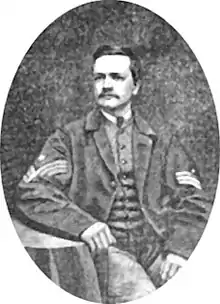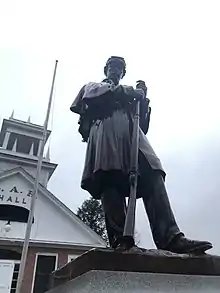Osgood T. Hadley
Osgood Towns Hadley (January 19, 1838 – October 5, 1914) was a Union Army soldier in the American Civil War who received the U.S. military's highest decoration, the Medal of Honor.[1][2]
Osgood T. Hadley | |
|---|---|
 | |
| Born | January 19, 1838 Nashua, New Hampshire |
| Died | October 5, 1914 (aged 76) |
| Buried | |
| Allegiance | |
| Service/ | |
| Rank | Sergeant |
| Unit | |
| Battles/wars | American Civil War |
| Awards | |
Hadley was born in Nashua, New Hampshire, on January 19, 1838. He married Susan F Carter (1841–1861) of Peterborough, New Hampshire, on November 14, 1860.[3] She died September 17, 1861, and Hadley enlisted and was mustered into Federal service November 27, 1861, at Peterborough, New Hampshire.
He was awarded the Medal of Honor for extraordinary heroism on September 30, 1864, while serving as a corporal with Company E, 6th New Hampshire Volunteer Infantry, at Pegram House, Virginia. Despite heavy enemy fire, Corporal Hadley retrieved and defended his colors and brought it back to his regiment. His Medal of Honor was issued, on July 27, 1896.[4][5][6][2]
After returning to New Hampshire, he married Sarah Naomi Ball (1848–1867) on September 22, 1865. She died July 4, 1867. The twice-widowed Hadley married a third time on November 25, 1868, to Lucy H. Brown Hadley (1845–1871). They had a son Willis Osgood Hadley (1870–1916) before she also died on January 15, 1871.[3]
He died at the age of 76, on October 5, 1914, having outlived three wives, and was buried at the Southborough Rural Cemetery in Worcester County, Massachusetts. His son only survived him by two years, dying at the Glencliffe Sanitorium from tuberculosis at age 45. However, his daughter-in-law and six grandchildren all lived lengthy lives into the second half of the twentieth century.[3]
The Osgood T. Hadley Memorial Bridge in Southborough, Massachusetts, is named in his honor.[7]

Medal of Honor citation
The President of the United States of America, in the name of Congress, takes pleasure in presenting the Medal of Honor to Corporal Osgood Towns Hadley, United States Army, for extraordinary heroism on 30 September 1864, while serving with Company E, 6th New Hampshire Veteran Infantry, in action at Pegram House, Virginia. As Color Bearer of his regiment Corporal Hadley defended his colors with great personal gallantry and brought them safely out of the action.[4][5][6][2]
Notes
- "Only one Nashuan in Fifth Regiment". Nashua Telegraph. 14 March 1961. p. 7. Retrieved August 8, 2014 – via Newspapers.com.

- CMOHS (2014).
- Find a Grave (2020).
- Subcommittee on Veterans' Affairs (1968), p. 105.
- Sightline Media Group (2020).
- VCOnline (2020).
- Brad Petrishen (24 May 2014). "A Southborough bridge for Osgood T. Hadley". MetroWest Daily News, Framingham, MA. Retrieved 10 August 2014.
References
- Dyer, Frederick H (1908). A Compendium of the War of the Rebellion. Des Moines, IA: Dyer Pub. Co. ASIN B01BUFJ76Q.
- Subcommittee on Veterans' Affairs, United States. Congress. Senate. Committee on Labor and Public Welfare (1968). Edward M Kennedy, Chairman (ed.). Medal of Honor, 1863-1968 : "In the Name of the Congress of the United States". Committee print (United States. Congress), 90th Congress, 2nd session. Washington DC: U.S. Government Printing Office. p. 1087. OCLC 1049691780.
- "Osgood Towns Hadley". The Hall of Valor Project. Sightline Media Group. 2020. Retrieved 19 May 2020.
- "Osgood Towns Hadley". THE COMPREHENSIVE GUIDE TO THE VICTORIA & GEORGE CROSS. VCOnline. 2020. Retrieved 2 May 2020.
- "HADLEY, OSGOOD T." Congressional Medal of Honor Society. CMOHS. 2014. Retrieved 19 August 2014.
- "Hadley, Osgood T". The National Medal of Honor Museum. The National Medal of Honor Museum Foundation. 2020. Retrieved 19 May 2020.
- "Osgood Towns Hadley (1838-1914) - Find A Grave Memorial". Find A Grave. 2020. Retrieved 19 May 2020.
External links
- Company C, 6th New Hampshire living history organization
- Company E, 6th New Hampshire living history organization